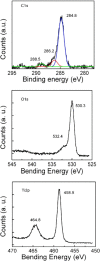Synthesis, characterization, and bioactivity of carboxylic acid-functionalized titanium dioxide nanobelts
- PMID: 25179214
- PMCID: PMC4237951
- DOI: 10.1186/s12989-014-0043-7
Synthesis, characterization, and bioactivity of carboxylic acid-functionalized titanium dioxide nanobelts
Abstract
Background: Surface modification strategies to reduce engineered nanomaterial (ENM) bioactivity have been used successfully in carbon nanotubes. This study examined the toxicity and inflammatory potential for two surface modifications (humic acid and carboxylation) on titanium nanobelts (TNB).
Methods: The in vitro exposure models include C57BL/6 alveolar macrophages (AM) and transformed human THP-1 cells exposed to TNB for 24 hrs in culture. Cell death and NLRP3 inflammasome activation (IL-1β release) were monitored. Short term (4 and 24 hr) in vivo studies in C57BL/6, BALB/c and IL-1R null mice evaluated inflammation and cytokine release, and cytokine release from ex vivo cultured AM.
Results: Both in vitro cell models suggest that the humic acid modification does not significantly affect TNB bioactivity, while carboxylation reduced both toxicity and NLRP3 inflammasome activation. In addition, short term in vivo exposures in both C57BL/6 and IL-1R null mouse strains demonstrated decreased markers of inflammation, supporting the in vitro finding that carboxylation is effective in reducing bioactivity. TNB instillations in IL-1R null mice demonstrated the critical role of IL-1β in initiation of TNB-induced lung inflammation. Neutrophils were completely absent in the lungs of IL-1R null mice instilled with TNB for 24 hrs. However, the cytokine content of the IL-1R null mice lung lavage samples indicated that other inflammatory agents, IL-6 and TNF-α were constitutively elevated indicating a potential compensatory inflammatory mechanism in the absence of IL-1 receptors.
Conclusions: Taken together, the data suggests that carboxylation, but not humic acid modification of TNB reduces, but does not totally eliminate bioactivity of TNB, which is consistent with previous studies of other long aspect ratio nanomaterials such as carbon nanotubes.
Figures













Similar articles
-
Effect of MWCNT size, carboxylation, and purification on in vitro and in vivo toxicity, inflammation and lung pathology.Part Fibre Toxicol. 2013 Nov 13;10(1):57. doi: 10.1186/1743-8977-10-57. Part Fibre Toxicol. 2013. PMID: 24225053 Free PMC article.
-
Mouse pulmonary dose- and time course-responses induced by exposure to nitrogen-doped multi-walled carbon nanotubes.Inhal Toxicol. 2020 Jan;32(1):24-38. doi: 10.1080/08958378.2020.1723746. Epub 2020 Feb 7. Inhal Toxicol. 2020. PMID: 32028803 Free PMC article.
-
Nanoparticles activate the NLR pyrin domain containing 3 (Nlrp3) inflammasome and cause pulmonary inflammation through release of IL-1α and IL-1β.Proc Natl Acad Sci U S A. 2010 Nov 9;107(45):19449-54. doi: 10.1073/pnas.1008155107. Epub 2010 Oct 25. Proc Natl Acad Sci U S A. 2010. PMID: 20974980 Free PMC article.
-
Hemorrhagic shock augments Nlrp3 inflammasome activation in the lung through impaired pyrin induction.J Immunol. 2013 May 15;190(10):5247-55. doi: 10.4049/jimmunol.1203182. Epub 2013 Apr 12. J Immunol. 2013. PMID: 23585683 Free PMC article.
-
Activation of NLRP3 inflammasome in alveolar macrophages contributes to mechanical stretch-induced lung inflammation and injury.J Immunol. 2013 Apr 1;190(7):3590-9. doi: 10.4049/jimmunol.1200860. Epub 2013 Feb 22. J Immunol. 2013. PMID: 23436933 Free PMC article.
Cited by
-
Fluorescence lifetime imaging microscopy and time-resolved anisotropy of nanomaterial-induced changes to red blood cell membranes.Methods Appl Fluoresc. 2021 May 7;9(3):10.1088/2050-6120/abf424. doi: 10.1088/2050-6120/abf424. Methods Appl Fluoresc. 2021. PMID: 33973872 Free PMC article.
-
Functionalized Titanium Nanoparticles Induce Oxidative Stress and Cell Death in Human Skin Cells.Int J Nanomedicine. 2022 Mar 30;17:1495-1509. doi: 10.2147/IJN.S325767. eCollection 2022. Int J Nanomedicine. 2022. PMID: 35388270 Free PMC article.
-
Lung deposition patterns of MWCNT vary with degree of carboxylation.Nanotoxicology. 2019 Mar;13(2):143-159. doi: 10.1080/17435390.2018.1530392. Nanotoxicology. 2019. PMID: 31111787 Free PMC article.
-
The role of NLRP3 inflammasome activation in proinflammatory and cytotoxic effects of metal nanoparticles.Arch Toxicol. 2025 Apr;99(4):1287-1314. doi: 10.1007/s00204-025-03972-x. Epub 2025 Feb 17. Arch Toxicol. 2025. PMID: 39960653 Review.
-
Autophagy deficiency in macrophages enhances NLRP3 inflammasome activity and chronic lung disease following silica exposure.Toxicol Appl Pharmacol. 2016 Oct 15;309:101-10. doi: 10.1016/j.taap.2016.08.029. Epub 2016 Sep 1. Toxicol Appl Pharmacol. 2016. PMID: 27594529 Free PMC article.
References
-
- Tan GL, Hommerich U, Temple D, Wu NQ, Zheng JG, Loutts G. Synthesis and optical characterization of CdTe nanocrystals prepared by ball milling process. Scripta Mater. 2003;48(10):1469–1474. doi: 10.1016/S1359-6462(03)00079-4. - DOI
-
- Duan DM, Wu NQ, Slaughter WS, Mao SX. Length scale effect on mechanical behavior due to strain gradient plasticity. Mat Sci Eng a-Struct. 2001;303(1–2):241–249. doi: 10.1016/S0921-5093(00)01907-9. - DOI
-
- Li M, Cushing SK, Wang QY, Shi XD, Hornak LA, Hong ZL, Wu NQ. Size-Dependent Energy Transfer between CdSe/ZnS Quantum Dots and Gold Nanoparticles. J Phys Chem Lett. 2011;2(17):2125–2129. doi: 10.1021/jz201002g. - DOI
-
- Li M, Cushing SK, Zhang JM, Lankford J, Aguilar ZP, Ma DL, Wu NQ: Shape-dependent surface-enhanced Raman scattering in gold-Ramanprobe-silica sandwiched nanoparticles for biocompatible applications.Nanotechnology 2012, 23(11):115501. - PubMed
-
- Zhi MJ, Koneru A, Yang F, Manivannan A, Li J, Wu NQ: Electrospun La0.8Sr0.2MnO3 nanofibers for a high-temperature electrochemical carbon monoxide sensor.Nanotechnology 2012, 23(30):305501. - PubMed
Publication types
MeSH terms
Substances
Grants and funding
LinkOut - more resources
Full Text Sources
Other Literature Sources

